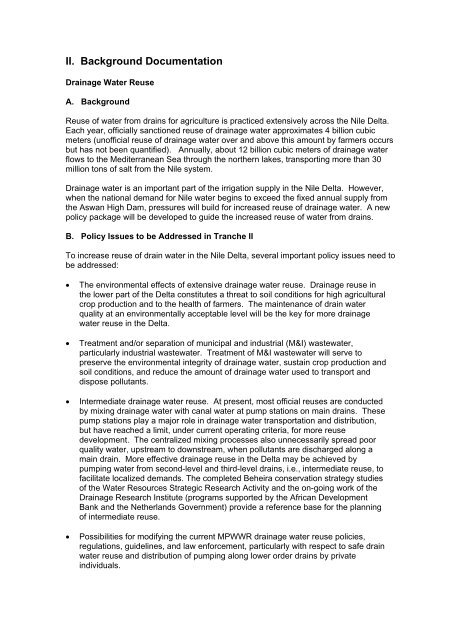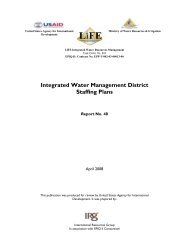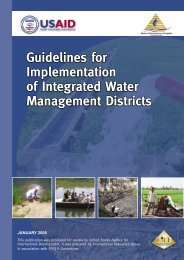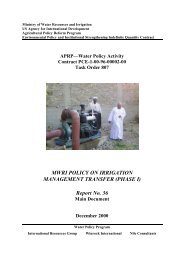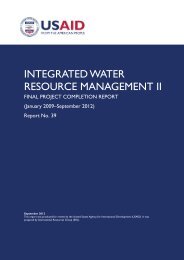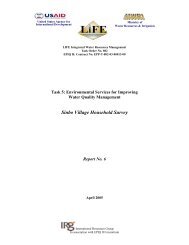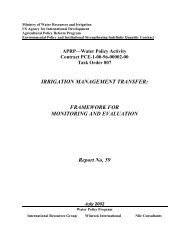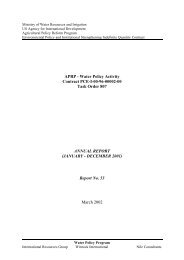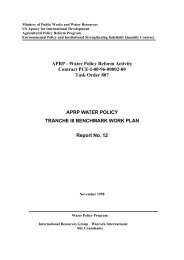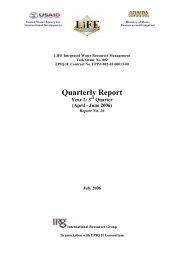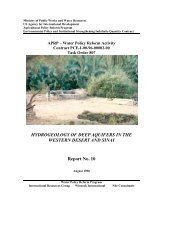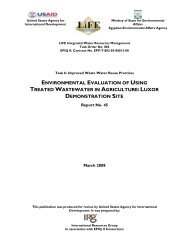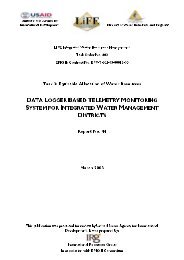APRP - Water Policy Reform - LIFE-IWRMII Project, Egypt
APRP - Water Policy Reform - LIFE-IWRMII Project, Egypt
APRP - Water Policy Reform - LIFE-IWRMII Project, Egypt
- No tags were found...
You also want an ePaper? Increase the reach of your titles
YUMPU automatically turns print PDFs into web optimized ePapers that Google loves.
II. Background DocumentationDrainage <strong>Water</strong> ReuseA. BackgroundReuse of water from drains for agriculture is practiced extensively across the Nile Delta.Each year, officially sanctioned reuse of drainage water approximates 4 billion cubicmeters (unofficial reuse of drainage water over and above this amount by farmers occursbut has not been quantified). Annually, about 12 billion cubic meters of drainage waterflows to the Mediterranean Sea through the northern lakes, transporting more than 30million tons of salt from the Nile system.Drainage water is an important part of the irrigation supply in the Nile Delta. However,when the national demand for Nile water begins to exceed the fixed annual supply fromthe Aswan High Dam, pressures will build for increased reuse of drainage water. A newpolicy package will be developed to guide the increased reuse of water from drains.B. <strong>Policy</strong> Issues to be Addressed in Tranche IITo increase reuse of drain water in the Nile Delta, several important policy issues need tobe addressed:• The environmental effects of extensive drainage water reuse. Drainage reuse inthe lower part of the Delta constitutes a threat to soil conditions for high agriculturalcrop production and to the health of farmers. The maintenance of drain waterquality at an environmentally acceptable level will be the key for more drainagewater reuse in the Delta.• Treatment and/or separation of municipal and industrial (M&I) wastewater,particularly industrial wastewater. Treatment of M&I wastewater will serve topreserve the environmental integrity of drainage water, sustain crop production andsoil conditions, and reduce the amount of drainage water used to transport anddispose pollutants.• Intermediate drainage water reuse. At present, most official reuses are conductedby mixing drainage water with canal water at pump stations on main drains. Thesepump stations play a major role in drainage water transportation and distribution,but have reached a limit, under current operating criteria, for more reusedevelopment. The centralized mixing processes also unnecessarily spread poorquality water, upstream to downstream, when pollutants are discharged along amain drain. More effective drainage reuse in the Delta may be achieved bypumping water from second-level and third-level drains, i.e., intermediate reuse, tofacilitate localized demands. The completed Beheira conservation strategy studiesof the <strong>Water</strong> Resources Strategic Research Activity and the on-going work of theDrainage Research Institute (programs supported by the African DevelopmentBank and the Netherlands Government) provide a reference base for the planningof intermediate reuse.• Possibilities for modifying the current MPWWR drainage water reuse policies,regulations, guidelines, and law enforcement, particularly with respect to safe drainwater reuse and distribution of pumping along lower order drains by privateindividuals.


